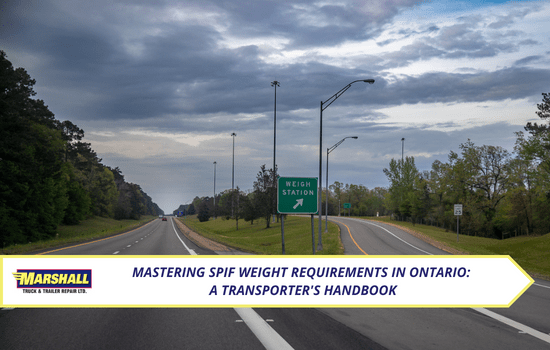Ontario, Canada, is known for its vast and intricate network of highways, making it a crucial hub for transportation and logistics. To ensure road safety and the longevity of its infrastructure, Ontario has established a comprehensive set of regulations governing commercial vehicle weight restrictions, including SPIF rules.
Navigating Ontario's SPIF Rules: Understanding Weight Restrictions
 In a previous blog, we shared the overarching components of SPIF Rules in Ontario. One key aspect of SPIF (Safe, Productive, and Infrastructure-Friendly) rules is weight restrictions for various types of vehicles. In this blog, we'll delve specifically into those weight restrictions and help you understand what every commercial driver and fleet operator should be aware of.
In a previous blog, we shared the overarching components of SPIF Rules in Ontario. One key aspect of SPIF (Safe, Productive, and Infrastructure-Friendly) rules is weight restrictions for various types of vehicles. In this blog, we'll delve specifically into those weight restrictions and help you understand what every commercial driver and fleet operator should be aware of.
Marshall Truck & Trailer Repair is a certified SPIF shop to ensure your truck and tractor-trailer meet current SPIF regulations.
A Brief Overview of Ontario’s SPIF Rules
SPIF rules were introduced to promote safety, protect road infrastructure, and enhance the productivity of commercial vehicles. There are four components of SPIF rules: weight restrictions, axle configuration standards, suspension specifications, brake performance requirements, and tire specifications. To have a more concrete understanding of SPIF, we suggest reading this blog, Understanding SPIF Rules in Ontario: Enhancing Road Safety and Efficiency.
Understanding Weight Restrictions
SPIF defines the allowable weights for different types of vehicles, axles, and axle configurations, ensuring that vehicles operating in Ontario adhere to standardized weight limits.
- Gross Vehicle Weight Rating (GVWR): The GVWR is the maximum weight a vehicle can legally operate at, including the vehicle's weight plus the weight of any cargo or passengers. SPIF rules specify GVWR limits for various types of vehicles, such as single-unit trucks, trucks and trailers, and more.
- Axle Weight Limits: SPIF rules set maximum weight limits for individual axles. These limits vary depending on the number of axles a vehicle has and their spacing. Axle weights are crucial to prevent excessive wear and tear on road surfaces and ensure vehicle stability.
- Axle Group Weights: Ontario's SPIF rules establish maximum weight limits for axle groups, such as tandem axles and tridem axles. These limits are designed to distribute weight evenly and prevent overloading of specific sections of the vehicle.
- Wheel Weights: SPIF rules also specify the maximum allowable weight per wheel. This restriction prevents excessive stress on individual tires and promotes even tire wear.
Enforcement and Consequences
It's essential to comply with Ontario's SPIF rules because violations can result in fines, vehicle impoundment, and increased road maintenance costs. Commercial drivers and fleet operators should ensure their vehicles are properly configured and loaded within the SPIF weight limits to avoid penalties.
Helpful Compliance Tips
- Regular Maintenance: Keep your vehicles well-maintained to ensure that all components, including axles and suspension systems, are in optimal condition.
- Load Distribution: Properly distribute cargo within the vehicle to maintain balance and avoid exceeding weight limits on specific axles or groups.
- Know the Rules: Familiarize yourself with Ontario's SPIF rules and stay updated on any changes or revisions. Check our blog, as we will continue to provide SPIF updates.
- Weighing Stations: Use weighing stations to check your vehicle's weight compliance during your journeys.
